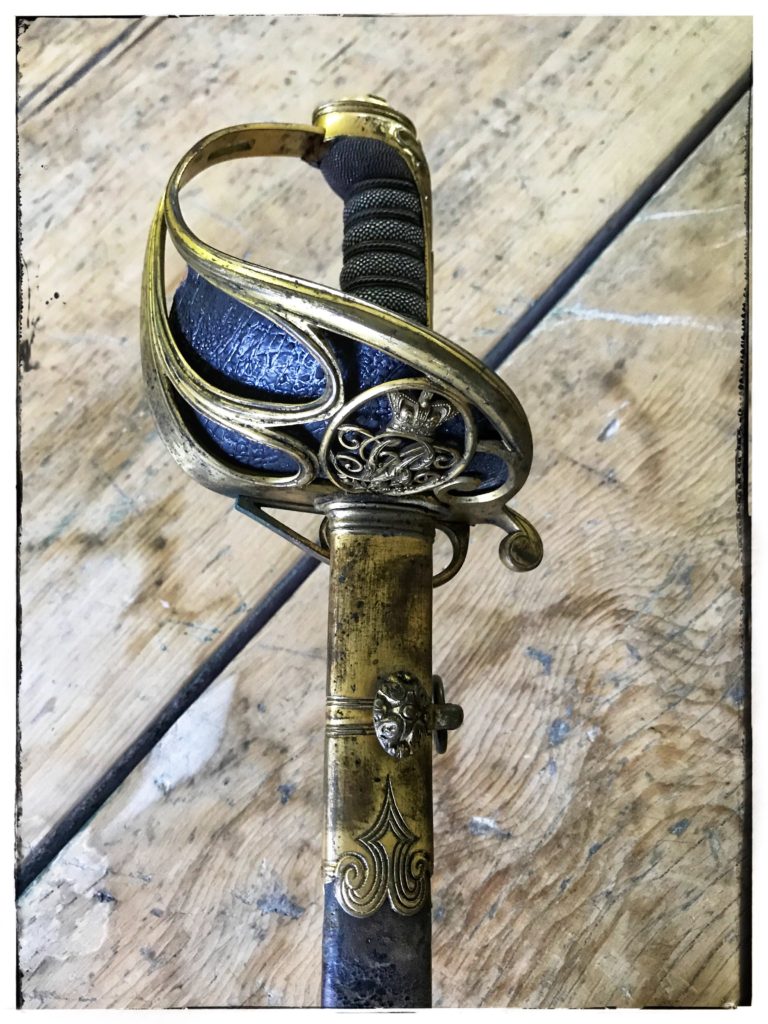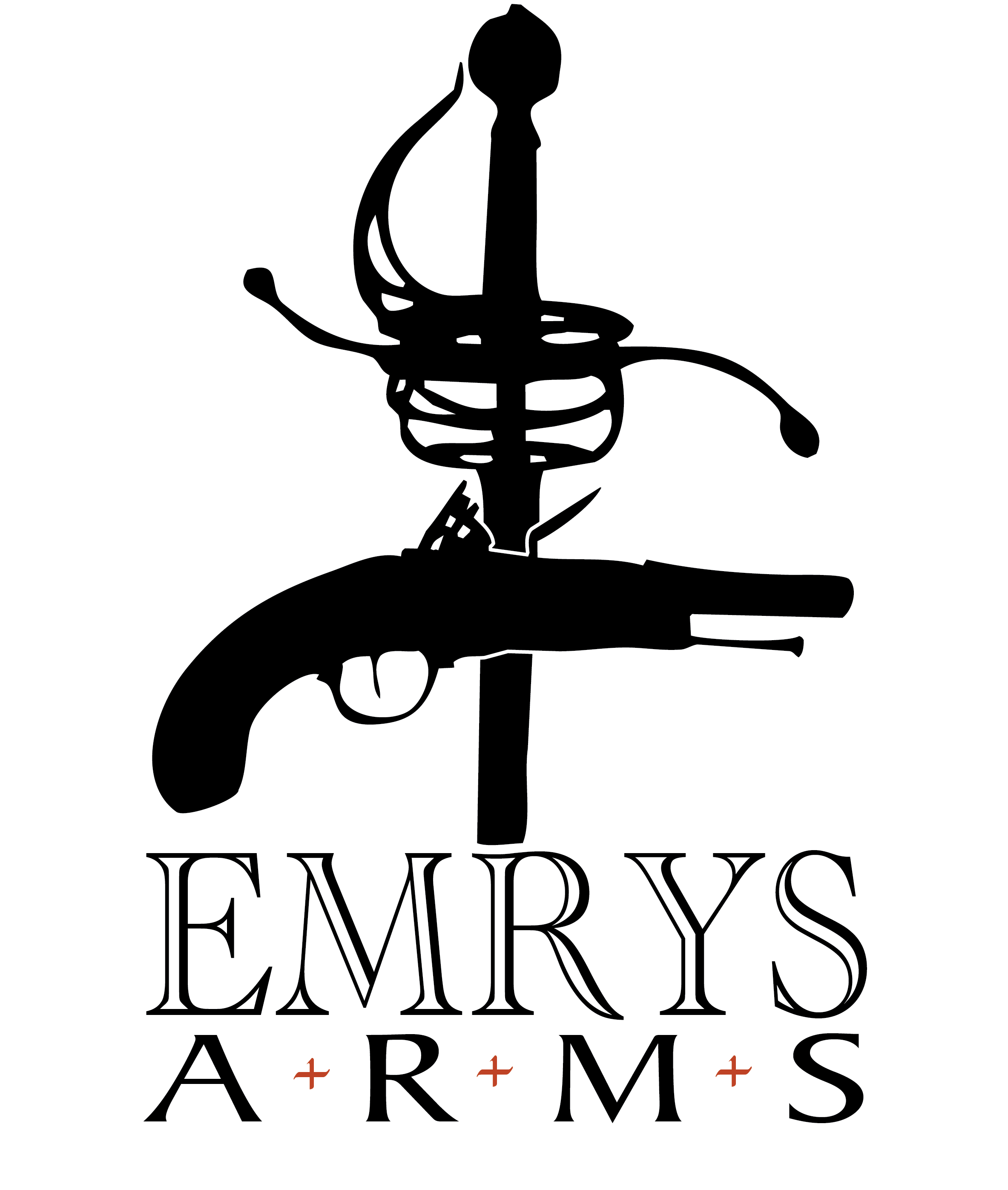| Collection #: | 2020.012 |
|---|---|
| Type: | Infantry Officer |
| Nationality: | British |
| Pattern: | 1822 |
| Date: | 1852 - 1874 |
| Hilt: | Gilt Brass |
| Blade Length: | 83cm (32 5/8") |
| Blade Width: | 2.5cm (1") |
| Overall Length: | 96.5cm (38") |
| Maker: | No Markings |

This sword technically is the British 1822 pattern officers’ sword of the Victorian era. However, it is slightly outside its time period. I will explain below after the general description. “The precise origins of this pattern of hilt remain obscure. The copying of French military fashion after 1815, under the influence of George, Prince Regent, leads one to look for a clue in that direction but no French sword of this period resembles the ‘Gothic Hilt’, which may conceivably owe something to Prosser who supplied the Prince Regent with numerous swords and scabbards at this time. In the 1822 Dress Regulations, it is described as ‘a gilt half-basket hilt with GR IV inserted in the outward bars’. The reference to ‘outward bars’ is significant because this guard is, in essence a three bar guard, [and could also have been included under that section of this website] with the bars linked by tracery. In its early form, the inner panel of the guard was hinged to fall down to allow the hilt to lie closer to the wearer’s body, and the scabbard has a small pin which fits into the guard. [Note: I have not seen this on any of my examples, but I have seen it on the 1827 pattern naval officers sword which has a very similar guard with the exception of the bars being filled in and the royal cypher replaced by a crowned fouled anchor] The hilt had a black leather lining to protect the wearer’s hand and gloves.
The blade was also entirely new in infantry swords, being a slender, slightly curved, pipe-backed design, double edged for the last few inches … The scabbard was black leather with decorated brass mounts.”
It is in very good condition, but why do I say it is outside of its time era? The reason is wrapped up in the pattern of sword versus the version of the royal cypher in the guard. The cypher, which is very beautifully and delicately executed consists of a crowned VR and beneath that a rose, thistle and shamrock which, according to Robson on page 164, did not come into use until the early 1850’s. However, by then the 1845 pattern blade had been adopted, replacing the pipe backed version. As per a “Circular Memorandum of 10 March 1845 from the Adjutant-General the new blade was described thus:
‘A blade of an improved construction and superior quality having been adopted to the sword prescribed for officers of infantry, a pattern of the sword thus improved has been sealed and deposited in the office of Military Boards for the inspection of tradesmen and regulation of future supplies – any deviation from which either as regards form, dimensions or weight as specified in the margin is positively prohibited.
It is to be understood, however, that officers are not required to provide themselves with swords of the improved pattern until those now in possession shall have been worn out’.” (Robson, Pages 159,161)
Additionally, while the blade was improved, the guard was also supposedly strengthened, yet if you compare this Victorian cyphered guard with the one on sword 2020.011, it definitely not a stronger guard. Of a higher quality definitely, but not stronger, I would say.
As to the latest that this sword could date to, we are looking at between 1872 and 1874 when “the black leather hilt lining was abandoned for all regiments” (Robson, pg.164). This is how I have arrived at a dating of this sword from the early 1850’s to somewhere between 1872 and 1874 which is also interesting as the folding guard was abolished in 1854, further narrowing our window of production to a span of possibly four years.
One explanation as to why this sword is not mounted with the improved blade can possibly be found in the memorandum above: that officers were not required to purchase new swords until the old one had worn out. It is possible that the sword was, as a cost conscious measure, simply rehilted with an updated guard. But just like buying a new laptop only to have a newer model released the following week, I can imagine this officers dismay at purchasing a new guard, only to have the new solid guard come out, at most a few years later.
I am very pleased with the condition of this piece. As you can see in the pictures below, a lot of the gilt is still remaining on the guard. There is absolutely no loss to the fish skin grip or wire binding. All the components are tight and firm, as is the folding guard. As mentioned before, the royal cypher in the blade is very beautifully done with great detail and chiselling. The leather guard liner is still present with just the top strip which wraps up to the pommel torn away.
The blade has a mirror shine (which made it somewhat difficult to photograph) with some slight areas starting to darken with age. There are unfortunately no makers marks to the spine or forte of the blade, only the cypher of Queen Victoria about a third of the way up. The blade is just under regulation width and while I am tempted to consider it a piquet weight example intended for dress occasions, it is also technically wider than the piquet weight examples and so falls in between. It is also slightly longer than regulation length.
The leather scabbard is present (which is saying something) and therefor also are all the brass mounts. The leather does have some weak spots to it and the stitching has given out from the middle band down to the chape. All in all, a very appealing example of the British 1822 Pattern Infantry Officers’ sword.
We use cookies to improve your experience on our site. By using our site, you consent to cookies. Enjoy the cookies...they're delicious...
Websites store cookies to enhance functionality and personalise your experience. You can manage your preferences, but blocking some cookies may impact site performance and services.
Essential cookies enable basic functions and are necessary for the proper function of the website.
Statistics cookies collect information anonymously. This information helps us understand how visitors use our website.
Google Analytics is a powerful tool that tracks and analyzes website traffic for informed marketing decisions.
Service URL: policies.google.com (opens in a new window)

